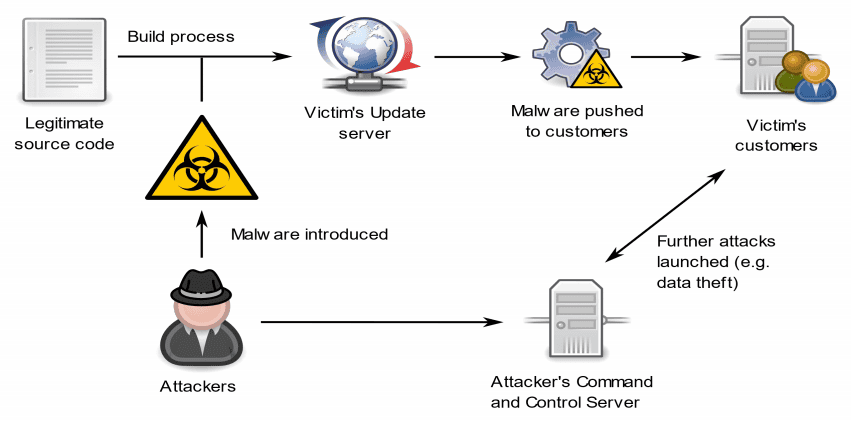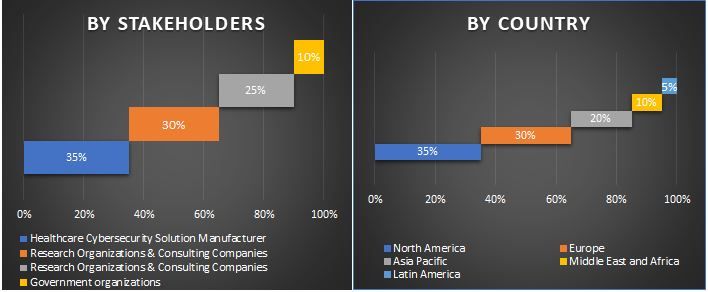- Home
- About Us
- Industry
- Services
- Reading
- Contact Us
Healthcare Cybersecurity Market: Current Analysis and Forecast (2021-2027)
Emphasis on Components (Solutions, Services), Deployment Type (Cloud, On-Premise); Threat Type (Ransomware, Malware & Spyware, Distributed Denial of Services (DDoS), Advanced Persistent Threats (APT), Others); Security Type (Network Security, Cloud Security, Content Security, End-Point Security, Application Security, Others); End-Users (Pharmaceutical and Biotechnology, Health Insurance, Hospitals, Others); and Region & Country.

Cyber-attacks and threats across healthcare facilities, pharma companies, R&D centers across the globe are becoming increasingly sophisticated. As per a report by checkpoint, a 45% increase in cyberattacks on healthcare organizations was witnessed between November and December in 2020. The adoption of new technologies such as AI, IoT, ML coupled with the lack of proper safety considerations is creating an opportunity for hackers to attack healthcare organizations. As per a report, more than 80% of healthcare IT leaders say their systems have been compromised.
Moreover, Increasing internet penetration and surging adoption of digital technologies such as IoMT, connected devices globally are resulting in increasing demand for cybersecurity solutions. During 2001-2021, the world registered 1,331.9% growth. An average hospital room contains 15 to 20 connected medical devices. In some hospitals, connected medical devices outnumber mobile devices, such as laptops and smartphones, 4 to 1. A large hospital could be home to as many as 85,000 connected devices. Moreover, around 60% of hospitals were using three or more connected health technologies as of 2018, as revealed by Deloitte.
As healthcare organizations continue to respond to the pandemic, cybercriminals persist in their attacks on providers, health plans, and business associates. More than 500 healthcare organizations have reported a breach of 500+ patient records to the Department of Health and Human Services (HHS) Office for Civil Rights (OCR) through the first 10 months of 2020, and it was expected that the numbers will surpass 550 by the end of 2020. In total, 513 entities have reported a significant breach so far, equating to 23.5 million individuals impacted. Furthermore, a rise in the healthcare data breach during a pandemic is leading to the greater adoption of cybersecurity solutions. The average cost of a breach in healthcare has increased 10.5% from 2019 to 2020. The average health care data breach costs its victim $7.13 million, the highest cost in 2020 across all industries. That is almost double the global average.
Value Chain in Healthcare Cybersecurity

Palo Alto Networks, Inc., Sophos Ltd., Cisco Systems, Inc., Checkpoint Software Technologies Ltd., IBM Corporation, McAfee LLC, Juniper Networks, Inc., Intel Corporation, Trend Micro Incorporated., etc., are some of the prominent players operating in the Healthcare Cybersecurity market. Several M&As along with partnerships have been undertaken by these players to facilitate customers with hi-tech and innovative products.
Insights Presented in the Report
“Amongst Components, Solutions segment holds the major share”
Based on the type of component, the market is fragmented into Solutions and Services. The Solutions segment dominated the market with a share of 61.4% in 2020 and is expected to maintain its dominance during the forecast period owing to the emerging demand due to the increasing adoption of technologies such as IoT, AI, ML, and connected health. However, the services are expected to witness the highest CAGR during the forecast period.
“Amongst Deployment Type, On-Premise segment dominated the market during the forecast period”
Based on Deployment Type, the market is mainly fragmented into Cloud and On-Premise. In 2020, the on-premise segment accounted for a maximum market revenue share of 62.6% and is expected to remain dominant during the analyzed period. The market of the on-premise segment is witnessing an uptick on account of the preference of enterprises to keep data confidential rather than shifting it to the cloud platform. Also, the benefits of control of security monitoring and hands-on ownership are some of the key benefits, due to which healthcare organizations prefer on-premise solutions.
“Amongst Threat Type, Ransomware segment grabbed Major Market share in 2020”
Based on Threat Type, the market is mainly fragmented into Ransomware, Malware & Spyware, Distributed Denial of Services (DDoS), Advanced Persistent Threats (APT), and Others. In 2020, the Ransomware segment grabbed the major market share and dominated the market. The segment gathered a 28.4% revenue share.
“Based on Security Type, Network Security Dominated the Market in 2020”
Based on Security Type, the market is mainly fragmented into Network Security, Cloud Security, Content Security, End-Point Security, Application Security, and Others. In 2020, the Network Security segment accounted for a maximum market revenue share of 31.3% and is expected to remain dominant during the analysed period. The market of network security segment is witnessing an uptick on account of the growing number and sophistication of cyberattacks prompts organizations to increase their healthcare network security. These attacks targeted patient medical records, billing information, log-in credentials, passwords and authentication, and clinical trial/research information
“Amongst End-User’s Type, Hospital Segment Dominated the Market in 2020”
The Healthcare Cybersecurity market is fragmented into Pharmaceutical and Biotechnology, Health Insurance, Hospitals, and Others. In 2020, the hospital segment grabbed the major market share and gathered 42.2% market share. Moreover, the trend of dominance is expected to remain the same in the forthcoming years as well.
“North America represents one of the largest markets of Healthcare Cybersecurity market”
For a better understanding of the market dynamics of the Healthcare Cybersecurity market, a detailed analysis was conducted for different regions across the globe including North America, Europe, Asia Pacific, and the Rest of the world. UAE. North America dominated the market and generated revenue of US$ 4,661.8 million in 2020 owing to the being technologically advanced and emerging number of healthcare facilities rely upon online facilities or connected health.
Reasons to buy this report:
- The study includes market sizing and forecasting analysis validated by authenticated key industry experts
- The report presents a quick review of overall industry performance at one glance
- The report covers an in-depth analysis of prominent industry peers with a primary focus on key business financials, product portfolio, expansion strategies, and recent developments
- Detailed examination of drivers, restraints, key trends, and opportunities prevailing in the industry
- The study comprehensively covers the market across different segments
- Deep dive regional level analysis of the industry
Customization Options:
Healthcare Cybersecurity Market can further be customized as per the requirement or any other market segment. Besides this, UMI understands that you may have your own business needs, hence feel free to connect with us to get a report that completely suits your requirements.
Table of Content
Analyzing the historical market, estimation of the current market, and forecasting the future market of the Healthcare Cybersecurity Market were the three major steps undertaken to create and analyze the adoption of cybersecurity solutions across major regions. Exhaustive secondary research was conducted to collect the historical market numbers and estimate the current market size. Secondly, to validate these insights, numerous findings and assumptions were taken into consideration. Moreover, exhaustive primary interviews were also conducted, with industry experts across the value chain of the healthcare cybersecurity market. Post assumption and validation of market numbers through primary interviews, we employed a top-down approach to forecast the complete market size. Thereafter, market breakdown and data triangulation methods were adopted to estimate and analyze the market size of segments and sub-segments the industry pertains to. Detailed methodology is explained below:
Analysis of Historical Market Size
Step 1: In-Depth Study of Secondary Sources:
Detailed secondary study was conducted to obtain the historical market size of the healthcare cybersecurity through company internal sources such as annual reports & financial statements, performance presentations, press releases, etc., and external sources including journals, news & articles, government publications, competitor publications, sector reports, third-party database, and other credible publications.
Step 2: Market Segmentation:
After obtaining the historical market size of the healthcare cybersecurity market, we conducted a detailed secondary analysis to gather historical market insights and share for different components, deployment, solutions & end-users for major regions. Major segments included in the report are solutions, threat type, security type, and end-users. Further region and country-level analyses were conducted to evaluate the overall adoption of healthcare cybersecurity across the globe.
Step 3: Factor Analysis:
After acquiring the historical market size of different segments and sub-segments, we conducted a detailed factor analysis to estimate the current market size of Healthcare Cybersecurity. Further, we conducted factor analysis using dependent and independent variables such as surging healthcare IT spending, adoption of connected health, rising incidence of cyberattacks. A thorough analysis was conducted for demand and supply-side scenarios considering top partnerships, merger and acquisition, business expansion, and product launches in the Healthcare Cybersecurity industry across the globe.
Current Market Size Estimate & Forecast
Current Market Sizing: Based on actionable insights from the above 3 steps, we arrived at the current market size, key players in the Healthcare Cybersecurity market, and market shares of the segments. All the required percentage shares split, and market breakdowns were determined using the above-mentioned secondary approach and were verified through primary interviews.
Estimation & Forecasting: For market estimation and forecast, weightage was assigned to different factors including drivers & trends, restraints, and opportunities available for the stakeholders. After analyzing these factors, relevant forecasting techniques i.e. bottom-up approach was applied to arrive at the market forecast about 2027 for different segments and subsegments across the major markets globally. The research methodology adopted to estimate the market size encompasses:
- The industry’s market size, in terms of value (US$) and the adoption rate of Healthcare Cybersecurity across the major markets domestically
- All percentage shares, splits, and breakdowns of market segments and sub-segments
- Key players in the Healthcare Cybersecurity market in terms of services offered. Also, the growth strategies adopted by these players to compete in the fast-growing market
Market Size and Share Validation
Primary Research: In-depth interviews were conducted with the Key Opinion Leaders (KOLs) including Top Level Executives (CXO/VPs, Sales Head, Marketing Head, Operational Head, and Regional Head, Country Head, etc.) across major regions. Primary research findings were then summarized, and statistical analysis was performed to prove the stated hypothesis. Inputs from primary research were consolidated with secondary findings, hence turning information into actionable insights.
Split of Primary Participants in Different Regions
Market Engineering
Data triangulation technique was employed to complete the overall market estimation and to arrive at precise statistical numbers of each segment and sub-segment of the Healthcare Cybersecurity market. Data was split into several segments & sub-segments post studying various parameters and trends in the areas of Components, Deployment, Type of Threat, Security Type, Solutions, and End-Users of the Healthcare Cybersecurity market.
Main Objective of the Healthcare Cybersecurity Market Study
The current & future market trends of Healthcare Cybersecurity were pinpointed in the study. Investors can gain strategic insights to base their discretion for investments from the qualitative and quantitative analysis performed in the study. Current and future market trends were determined the overall attractiveness of the market at a regional level, providing a platform for the industrial participant to exploit the untapped market to benefit as a first-mover advantage. Other quantitative goals of the studies include:
- Analyze the current and forecast market size of Healthcare Cybersecurity in terms of value (US$). Also, analyze the current and forecast market size of different segments and sub-segments
- Segments in the study include areas of component, deployment, solutions, security type, and End-user sector
- Define and analysis of the regulatory framework for the Healthcare Cybersecurity industry
- Analyze the value chain involved with the presence of various intermediaries, along with analyzing customer and competitor behaviors of the industry
- Analyze the current and forecast market size of the Healthcare Cybersecurity market for the major countries
- The major region studied in the report includes North America, Europe, Asia- Pacific and Rest of the World.
- Company profiles of the Healthcare Cybersecurity market and the growth strategies adopted by the market players to sustain in the fast-growing market
- Deep dive regional level analysis of the industry
Related Reports
Customers who bought this item also bought











